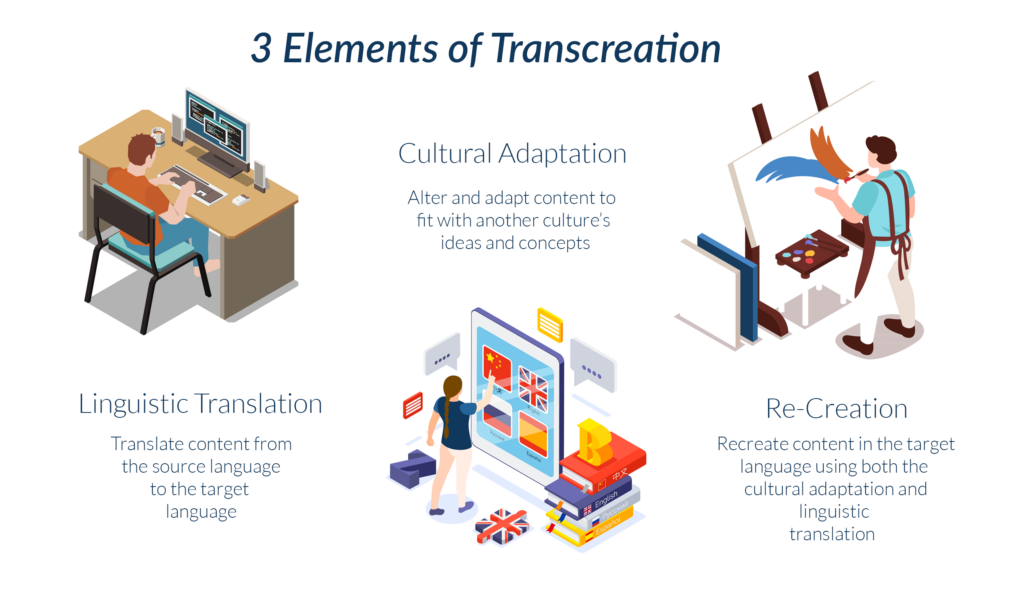In the intricate landscape of global communication, the lines between translation and transcreation can sometimes blur. While both are essential tools for crossing language barriers, they serve different purposes and are used in distinct contexts. So, when does a straightforward translation evolve into a more nuanced transcreation? This article aims to demystify these two closely related yet distinct services, helping you understand when translation becomes transcreation, what sets them apart, and why it matters for your international communication needs.
Is Transcreation a Type of Translation?
Transcreation is often considered a specialized type of translation, but it’s more accurate to say that it’s an extension or evolution of traditional translation. While translation and transcreation aim to convey a message from one language to another, transcreation goes a step further by adapting the content to resonate emotionally and culturally with the target audience.
In standard translation, the primary focus is on linguistic accuracy—converting text from the source language to the target language while maintaining the original message’s integrity. Transcreation, on the other hand, involves a deeper level of adaptation. It translates the words and reimagines the message, considering cultural nuances, idiomatic expressions, and emotional tone.
So, while transcreation incorporates translation elements, it also requires creative writing skills and a deep understanding of both the source and target cultures. This makes it a unique discipline at the intersection of translation, creative writing, and cultural adaptation.
Now that you know more about transcreation, let’s explore its outstanding aspects.
What is the Process of Transcreation?
The transcreation process involves three main steps:
- understanding the source material,
- adapting it culturally,
- and ensuring it resonates emotionally with the target audience.
What are the Elements of Transcreation?
The three elements of transcreation are linguistic accuracy, cultural adaptation, and emotional resonance. These elements work in tandem to ensure that the message is accurate, impactful, and relatable to the target audience.

What are the Types of Transcreation?
There are various types of transcreation, including marketing transcreation, literary transcreation, and audio-visual transcreation, each requiring a unique set of skills and approaches.
When Translation Becomes Transcreation
This shift occurs when the task goes beyond the literal conversion of text from one language to another and delves into cultural and emotional adaptation. In other words, translation becomes transcreation when the objective is not just to translate the words but also to capture the essence, tone, and emotional impact of the original message in a way that resonates with the target audience.
As mentioned before, in a standard translation project, the primary focus is linguistic accuracy. The goal is to ensure that the translated text faithfully represents the original, adhering closely to its grammatical structure and vocabulary. However, this approach may not always be sufficient, primarily when the text is intended to evoke specific emotions or persuade the audience.
Transcreation comes into play when the text needs to be culturally adapted to fit the target audience’s norms, values, and expectations. This often involves creative liberties, such as changing idioms, metaphors, or even the structure of the message to make it more relatable and impactful for the new audience.
So, when translation becomes transcreation, the linguist is not just a translator, a cultural consultant, and a creative writer all rolled into one. This is why transcreation is often more time-consuming and expensive than standard translation. Still, the investment is usually well worth it for materials where emotional and cultural impact is crucial.
One transcreation example would be a translated poem, which may not capture the emotional essence of the original, but a transcreated version will. Another example is a marketing slogan: it works well in English but may lose its punch when directly translated into another language. Transcreation ensures that the slogan is translated and transformed in a way that retains its original intent, style, and emotional impact. For more information about marketing translation, you can take a look at our article about Marketing Translation.
Is Transcreation More Expensive than Translation?
Yes, transcreation is generally more expensive than standard translation. The higher cost is due to the complexity and specialized skills required for transcreation. Unlike translation, which focuses primarily on linguistic accuracy, transcreation involves a deeper level of cultural and emotional adaptation. It requires the linguist to be an expert in both the source and target languages and have a strong understanding of cultural nuances, idioms, and emotional tones.
Transcreation often involves creative writing skills, as the linguist may need to rewrite slogans, adapt idioms, or even change the structure of the message to make it more impactful for the target audience. This creative effort, combined with the need for cultural expertise, makes transcreation a more time-consuming and skill-intensive process.
Because of these additional layers of complexity, transcreation rates are higher than standard translation rates. The investment, however, is often justified for projects where maintaining the emotional impact and cultural relevance of the original message is crucial, such as in marketing campaigns, advertisements, and brand communications.
Finding Transcreators Has Never Been Easier
So, whether you’re looking to break cultural barriers and truly connect with your target audience or deal with content where the emotional and cultural context is as important as the words themselves, transcreation may be worth the higher cost.
Ready to get started on your next translation project? Traduality has everything you need to succeed; create your first project today and find vetted translators, or book a meeting with us to learn more about your specific needs.
Updated 2/21/2024.





0 Comments